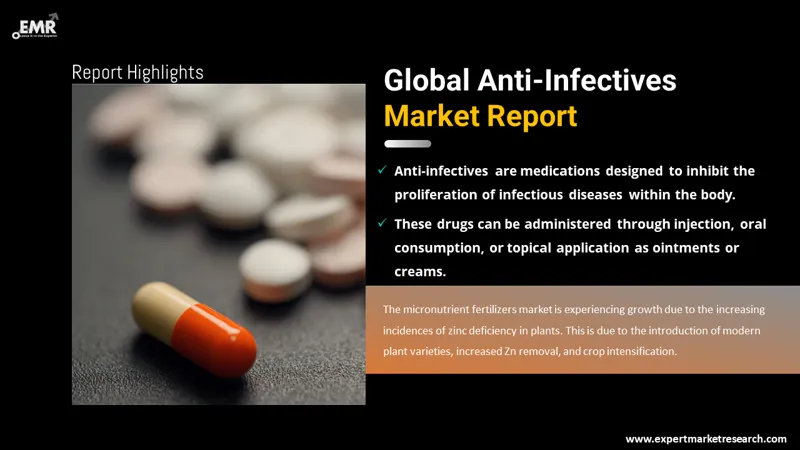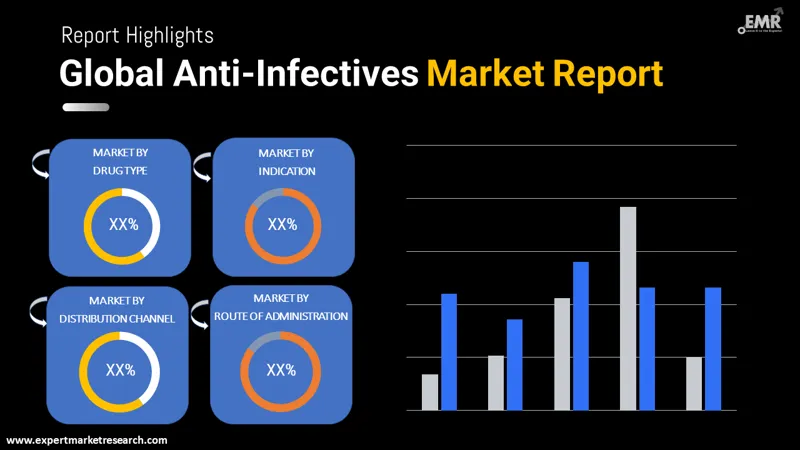
Consumer Insights
Uncover trends and behaviors shaping consumer choices today
Procurement Insights
Optimize your sourcing strategy with key market data
Industry Stats
Stay ahead with the latest trends and market analysis.
The global anti-infectives market size was valued at USD 134.24 Billion in 2025, driven by the rising prevalence of infectious diseases caused due to unhealthy environments, lack of proper sanitation, and unhygienic lifestyle. The market is anticipated to grow at a CAGR of 4.30% during the forecast period 2026-2035 to reach a value of USD 204.51 Billion by 2035.
Base Year
Historical Period
Forecast Period
Compound Annual Growth Rate
4.3%
Value in USD Billion
2026-2035
*this image is indicative*
The rising prevalence of infectious diseases, particularly across the low- and middle-income countries, has led to a surge in demand for anti-infectives to curtail the spread of infection. This has been driving the market growth of anti-infectives.

Read more about this report - REQUEST FREE SAMPLE COPY IN PDF
As a result of the increasing incidences of infectious agents, including bacteria, fungi, and viruses that are born from unhealthy environments lacking proper sanitation has led to the increasing incidences of diseases like diarrhoea, seasonal viral fevers, and skin infections, among others. Anti-infective agents act against the reproduction of the source of infection in the body over the course of time, and hence gradually killing the infection. Thus, the effectiveness of anti-infective agents is propelling the growth of the market.

Read more about this report - REQUEST FREE SAMPLE COPY IN PDF
Anti-infectives are medicines that are capable of restraining the spread of an infectious disease inside the body. These medicines can either be injected, consumed orally, or can be applied to the skin as ointments or creams.
On the basis of type, the market can be divided into:
Based on route of administration, the market can be categorised into:
The market, based on distribution channel, can be segmented into:
The EMR report looks into the regional markets of anti-infectives like:
The market for anti-infectives is rapidly growing due to the robust investments aimed at research and development (R&D) for the production of effective anti-infectives. Owing to the increasing antimicrobial resistance to existing anti-infective agents, the pharmaceutical sector is constantly innovating and researching to produce strong anti-infectives, which is augmenting the growth of the market. In addition, robust commercialisation schemes aimed at spreading knowledge about the existence of anti-infective agents in the market is furthering the market growth of anti-infectives. Moreover, the increasing awareness regarding the avoidable risks associated with early treatment of infectious diseases is further boosting the market growth of anti-infectives globally.
The report presents a detailed analysis of the following key players in the global anti-infectives market, looking into their capacity, market share, and latest developments like capacity expansions, plant turnabouts and mergers and acquisitions:
The comprehensive report looks at the micro and macro aspects of the industry. The EMR report gives an in-depth insight into the market by providing a SWOT analysis as well as an analysis of the Porter’s Five Forces Model.




*While we strive to always give you current and accurate information, the numbers depicted on the website are indicative and may differ from the actual numbers in the main report. At Expert Market Research, we aim to bring you the latest insights and trends in the market. Using our analyses and forecasts, stakeholders can understand the market dynamics, navigate challenges, and capitalize on opportunities to make data-driven strategic decisions.*
Get in touch with us for a customized solution tailored to your unique requirements and save upto 35%!
The global anti-infectives market reached a value of USD 134.24 Billion in 2025.
The market is anticipated to grow at a CAGR of 4.30% during the forecast period of 2026-2035 to reach a value of USD 204.51 Billion by 2035.
The market is being driven by the rising prevalence of infectious diseases caused due to unhealthy environments, lack of proper sanitation, and unhygienic lifestyles.
Robust investments into the pharmaceutical sector for the development of advanced anti-infectives and growing awareness regarding the early treatment of infection is leading to the growth of the market.
The major regional markets for anti-infectives are North America, Latin America, the Asia Pacific, Europe, and the Middle East and Africa.
The major types of anti-infectives are antibacterial, antifungal, and antiviral.
The different routes of administration are topical, oral, and intravenous (IV), among others.
The various distribution channels of anti-infectives are hospital pharmacy, retail pharmacy, speciality pharmacy, and online, among others.
The major players in the industry are Gilead Sciences, Inc., Sandoz International GmbH, Pfizer Inc., GlaxoSmithKline plc., and Abbott Laboratories, among others.
Explore our key highlights of the report and gain a concise overview of key findings, trends, and actionable insights that will empower your strategic decisions.
| REPORT FEATURES | DETAILS |
| Base Year | 2025 |
| Historical Period | 2019-2025 |
| Forecast Period | 2026-2035 |
| Scope of the Report |
Historical and Forecast Trends, Industry Drivers and Constraints, Historical and Forecast Market Analysis by Segment:
|
| Breakup by Drug Type |
|
| Breakup by Indication |
|
| Breakup by Route of Administration |
|
| Breakup by Distribution Channel |
|
| Breakup by Region |
|
| Market Dynamics |
|
| Supplier Landscape |
|
| Companies Covered |
|
| Report Price and Purchase Option | Explore our purchase options that are best suited to your resources and industry needs. |
| Delivery Format | Delivered as an attached PDF and Excel through email, with an option of receiving an editable PPT, according to the purchase option. |
Datasheet
One User
USD 3,299
USD 2,969
tax inclusive*
Single User License
One User
USD 5,499
USD 4,949
tax inclusive*
Five User License
Five User
USD 6,999
USD 5,949
tax inclusive*
Corporate License
Unlimited Users
USD 8,199
USD 6,969
tax inclusive*
*Please note that the prices mentioned below are starting prices for each bundle type. Kindly contact our team for further details.*
Flash Bundle
Small Business Bundle
Growth Bundle
Enterprise Bundle
*Please note that the prices mentioned below are starting prices for each bundle type. Kindly contact our team for further details.*
Flash Bundle
Number of Reports: 3
20%
tax inclusive*
Small Business Bundle
Number of Reports: 5
25%
tax inclusive*
Growth Bundle
Number of Reports: 8
30%
tax inclusive*
Enterprise Bundle
Number of Reports: 10
35%
tax inclusive*
How To Order

Select License Type
Choose the right license for your needs and access rights.

Click on ‘Buy Now’
Add the report to your cart with one click and proceed to register.

Select Mode of Payment
Choose a payment option for a secure checkout. You will be redirected accordingly.
Gain insights to stay ahead and seize opportunities.

Get insights & trends for a competitive edge.

Track prices with detailed trend reports.

Analyse trade data for supply chain insights.

Leverage cost reports for smart savings

Enhance supply chain with partnerships.

Connect For More Information
Our expert team of analysts will offer full support and resolve any queries regarding the report, before and after the purchase.
Our expert team of analysts will offer full support and resolve any queries regarding the report, before and after the purchase.
We employ meticulous research methods, blending advanced analytics and expert insights to deliver accurate, actionable industry intelligence, staying ahead of competitors.
Our skilled analysts offer unparalleled competitive advantage with detailed insights on current and emerging markets, ensuring your strategic edge.
We offer an in-depth yet simplified presentation of industry insights and analysis to meet your specific requirements effectively.
Share